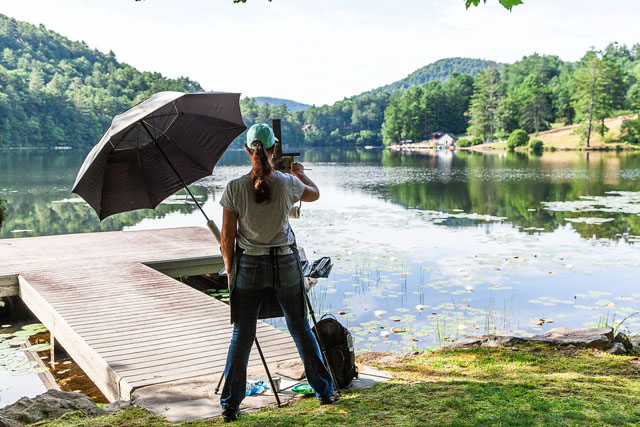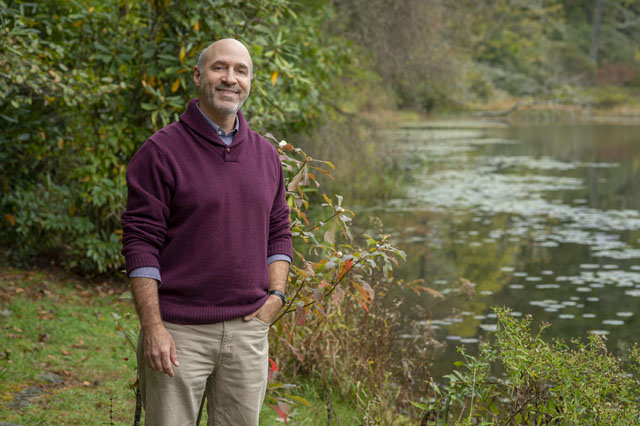A Wading Encyclopedia
04 Jun 2024
Matt Canter wants to ensure that future generations are catching for a lifetime
By Brendon Voelker
Photos by Matt Canter

When it comes to fly-fishing, there are few individuals that match the tenure of professional angler, Matt Canter. Owner of Brookings, a local outfitter specializing in fly-fishing around the plateau, you’ll be hard-pressed to find an outdoor guide that won’t reference his knowledge and experience along the way.
Even if you don’t hear his name directly, chances are he’s influenced almost anyone who has set a hook on a trout in the southern Appalachian Mountains. His knowledge is incredible, unending, and most of all, inspiring. Matt could be easily described as a wading encyclopedia. There are few waterways he hasn’t explored.
Canter began guiding in 2004 then started his career with Brookings shortly after in 2006. At the time, he was out fishing in Panthertown with his then-future wife, Natalie. “We stopped into Brookings to pick up a few flies for the day and just check out the store,” he reminisces. “In conversation with the store clerk, she learned that I was a fly-fishing guide in the northern part of the country and told me that Brookings was in search of another guide.” Having been impressed with the store already, he knew if he were to fill the position, he would be taking his career in the right direction. Just one week later, and following an interview, he secured his role as a full-time guide for the shop.
When asked of his favorite memory on the water, he reminisces on when his daughter caught her very first fish on a fly rod at just 4 years old. Adding to the sentimental value, “the fly rod she caught it on was a 4’, 2w bamboo rod that was handcrafted by a good friend, and local legend, Henry Williamson. While he works with businesses and individuals alike, these individual experiences are something that sticks out to him.
Matt has a hard time pinning down an all-time favorite spot, but the Chattooga River holds a special place in his heart. As with any other guide, he’s always scouting out other areas as well, especially small, accessible streams that are home to native brook trout. While the average size may be smaller than other species, the brook trout population has been dwindling over the decades, so having knowledge of where they are re-establishing their population is critical. It so happens that it’s his favorite species to fish for as well.
“Guiding, if done properly, is super intimidating, stressful and rewarding all at the same time. If you are doing it right, you want to make every trip one that the client will never forget, and you have to take whatever weather conditions and skill levels you have and roll with it,” he notes. It’s an easy undertaking when the client wants to “have a good time, learn some things and enjoy mother nature.” In contrast, it can be challenging when the perception of success is based on the quantity or size of the catch.
Within his industry, it’s either feast or famine. Lately, the cost of living has complicated things, as many of the premier destinations are now some of the most costly to live in. “There is an old slogan that trout don’t live in ugly places, and that is very true… and places that aren’t ugly have gotten very expensive to live in over the last decade.” As a seasonal job for most, finding employees and guides has become increasingly difficult. Still, fishing has become “the best way to disconnect from everyday life and have an intimate interaction with mother nature.”
As another saying goes, a bad day on the water is better than a good day in the office. Whether the day yields the catch of a lifetime or a couple of native brookies, it’s likely you’ll find Matt at one of our local watering holes. Still, his family calls Brevard home. He chooses to commute to Cashiers for work on a regular basis, “and yes, of course, the fish played a huge part in the decision on where to settle down,” he remarks.
In alignment with his values, Canter only eats trout when backpacking in remote areas that see very little fishing pressure. He prefers pan frying and usually sticks to smaller fish in the 7-10 inch range. With a little Cajun fish fry seasoning, and some hot vegetable oil, he cooks them just enough to brown both sides, then devours everything but the bones. If you were at the next campsite over, chances are you might make your way over when that Cajun scent begins to fill the air.
A self-proclaimed “gear junkie,” Canter tends to trade out old gear for new as the latest and greatest make their way into the shop each season. “You name it, chances are I’ve got it, or have had it,” but fishing isn’t his only vice. Hiking, mountain biking, hunting and photography are all hobbies of his, the latter awarding clients with photos to remember their experience with him.
To ensure future generations can enjoy the sport in the same ways we can now, sustainable fly-fishing trickles down to “protecting the resource that you depend on.” He continues, “Conservation efforts are important, but also being good stewards to not over-publicize any particular access point or waterway.” Social media has complicated the issue further. On one hand, it helps promote what you do; on the other hand, it can lead to too much pressure on a particular area, ultimately damaging the natural resources.
Visit Brookings at 88 Cashiers Lake Road or give them a call at (828) 743-3768 to inquire about a guided fly-fishing trip on our local waterways.
You Can Help Prioritize
Trout Unlimited, the nation’s oldest and largest coldwater conservation organization, recently launched its Priority Waters initiative, a new approach to conservation built around identifying rivers and streams where TU can have the greatest impact by focusing the energy of its staff, members and supporters into building trout and salmon strongholds for the long term.
In North Carolina, several watersheds and regions have been identified as Priority Waters where communities can come together to make the biggest impact. Those areas include the headwaters of the Little Tennessee watershed, the Chattooga/Savannah River Basin, and “Sky Island,” a high-elevation region west of Hendersonville that includes the Mills, Tuckasegee and Davidson River watersheds.
In collaboration with key partners, including the US Forest Service, TU is tackling an array of projects in these areas to make streams healthier for wild trout, including native brook trout.
TU is replacing undersized and perched culverts with bridges or larger culverts to reconnect streams, repairing eroded stream banks to reduce the amount of sediment washing downstream, and adding structure such as large rocks and trees to streams to increase fish-holding habitat.
Post-project surveys show that such projects help support more and bigger trout and healthier ecosystems overall.
But that kind of work isn’t just good for fish and fishing. The projects have the additional benefit of making the streams and the infrastructure of the communities through which they flow more resilient to high flows that are becoming more prevalent in our changing climate. Simply put, as opposed to streams that overwhelm small culverts, those that flow cleanly under bridges don’t wash out roads.
There are ample efforts for the public to participate in these efforts, from community science initiatives such as stream surveys to helping with tree plantings at project sites. To learn more about TU’s efforts in the southern Appalachians, visit prioritywaters.tu.org, or reach out to TU’s southern Appalachian program director Abigail McQueen at abigail.mcqueen@tu.org













